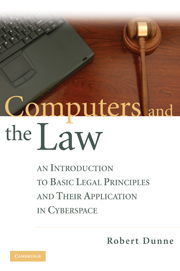Book contents
- Frontmatter
- Contents
- PREFACE
- ACKNOWLEDGMENTS
- 1 THE COMMON LAW AND STATUTORY LAW
- 2 CONTRACTS
- 3 TORTS INTRODUCTION
- 4 DEFAMATION
- 5 THIRD PARTY LIABILITY
- 6 COPYRIGHTS
- 7 TRADE SECRETS
- 8 TRADEMARKS
- 9 THE RIGHT OF PRIVACY
- 10 E-MAIL
- 11 THE RIGHT OF PUBLICITY
- 12 CONSTITUTIONAL LAW
- 13 PORNOGRAPHY AND OBSCENITY
- 14 ADVERTISING AND SPAM
- 15 JURISDICTION
- AFTERWORD
- INDEX
1 - THE COMMON LAW AND STATUTORY LAW
Published online by Cambridge University Press: 05 June 2012
- Frontmatter
- Contents
- PREFACE
- ACKNOWLEDGMENTS
- 1 THE COMMON LAW AND STATUTORY LAW
- 2 CONTRACTS
- 3 TORTS INTRODUCTION
- 4 DEFAMATION
- 5 THIRD PARTY LIABILITY
- 6 COPYRIGHTS
- 7 TRADE SECRETS
- 8 TRADEMARKS
- 9 THE RIGHT OF PRIVACY
- 10 E-MAIL
- 11 THE RIGHT OF PUBLICITY
- 12 CONSTITUTIONAL LAW
- 13 PORNOGRAPHY AND OBSCENITY
- 14 ADVERTISING AND SPAM
- 15 JURISDICTION
- AFTERWORD
- INDEX
Summary
Introduction
“Common Law” is frequently characterized as “judge-made law.” It is the law of precedent, created through a process of constant evolution as courts interpret and apply previous judicial decisions. While it is true that, as many people insist, judges do not make laws (lower case “l”) but legislatures do, judges do shape society's legal fabric – its Law (upper case “L”) – through this interpretive process.
“Statutory Law” is the law of “statutes” or what we commonly refer to simply as “laws,” created by legislative bodies such as Congress, state legislative counterparts of Congress, or other such bodies. Unlike Common Law, Statutory Law is a product of attempts to take a broad view and, usually, to make major adjustments to the Law. Common Law is built in a more piece-by-piece fashion, one brick at a time, by practitioners who are not concerned with the big picture, but rather with the case at hand.
The U.S. Federal Court system is essentially a three-tiered system, resembling a pyramid. At the lowest level are the District Courts, scattered all over the country. There are currently ninety-four federal District Courts. Each state has at least one, as do the District of Columbia and Puerto Rico. Three Territories of the United States also have Federal District Courts – Puerto Rico, Guam, and the Northern Mariana Islands. The District Courts are usually the starting point for litigation or prosecution if federal courts have jurisdiction over a case (which will be discussed in Chapter 15).
- Type
- Chapter
- Information
- Computers and the LawAn Introduction to Basic Legal Principles and Their Application in Cyberspace, pp. 1 - 22Publisher: Cambridge University PressPrint publication year: 2009



